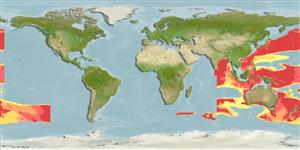Élasmobranches (requins et raies) (sharks and rays) >
Squaliformes (Sleeper and dogfish sharks) >
Squalidae (Dogfish sharks)
Etymology: Squalus: Genus name from Latin 'squalus' meaning shark (Ref. 6885, 27436); edmundsi: Named for Matt Edmunds, formerly with CSIRO Marine Laboratory in the 1990s..
More on authors: White, Last & Stevens.
Environment: milieu / climate zone / depth range / distribution range
Écologie
marin; profondeur 204 - 850 m (Ref. 58442), usually 300 - 500 m (Ref. 58442). Tropical
Eastern Indian Ocean: Western Australia and Indonesia.
Taille / Poids / Âge
Maturity: Lm ? range ? - ? cm
Max length : 70.0 cm TL mâle / non sexé; (Ref. 58442); 86.6 cm TL (female)
Description synthétique
Morphologie | Morphométrie
This moderate-sized species of the ‘mitsukurii group’ has the following set of characters: moderately elongate body, depth 9.9-11.5% TL; narrowly triangular snout, moderately long, preoral length 2.0-2.44 times the horizontal prenarial length, 10.3-10.8% TL, mouth width 1.56-1.81 (1.73) times the horizontal prenarial length; pre-first dorsal length 27.7-30.0 (28.5)% TL; pre-second dorsal length 60.2-62.9 (61.3)% TL; interdorsal space 23.5-25.6 (24.7)% TL; weakly bifurcated anterior nasal flap; first dorsal fin large, upright, first dorsal-fin height 7.0-8.0% TL; first dorsal-fin spine strong, upright and broad-based; second dorsal-fin spine long, moderately broad-based; prepectoral length 21.9-23.1 (22.6)% TL; pelvic-caudal space 25.0-26.7 (25.9)% TL; pectoral fin of adult individuals not falcate; pectoral-fin inner margin relatively short, 6.4-7.1% TL; caudal bar is oblique, extending along base of lower lobe to caudal fork, less than 0.1-0.2 of posterior margin of upper lobe, upper caudal fringe narrow, with a large dark saddle, distinctly closer to tip of lobe than its base; flank denticles are strongly tricuspidate; monospondylous centra 43-44, precaudal centra 86-91, total centra 1130-120 (Ref. 58442).
Commonly caught by demersal longline fisheries operating in deepwater; utilized for its meat, fins and liver oil which is of high value (Ref. 58048).
Life cycle and mating behavior
Maturité | Reproduction | Frai | Œufs | Fécondité | Larves
Distinct pairing with embrace (Ref. 205).
White, W.T., P.R. Last and J.D. Stevens, 2007. Two new species of Squalus of the 'mitsukurii group' from the Indo-Pacific. pp. 71-81. In P.R. Last, W.T. White and J.J. Pogonoski Descriptions of new dogfishes of the genus Squalus (Squaloidea: Squalidae). CSIRO Marine and Atmospheric Research Paper No. 014. 130 pp. (Ref. 58442)
Statut dans la liste rouge de l'IUCN (Ref. 130435)
Menace pour l'homme
Harmless
Utilisations par l'homme
Plus d'informations
PaysZones FAOÉcosystèmesOccurrencesIntroductionsStocksÉcologieRégime alimentaireÉléments du régime alimentaireConsommation alimentaireRation
Taille/ÂgeCroissanceLongueur-poidsLongueur-longueurFréquences de longueursMorphométrieMorphologieLarvesDynamique des populations larvairesRecrutementAbondanceBRUVS
RéférencesAquacultureProfil d'aquacultureSouchesGénétiqueElectrophoresesHéritabilitéPathologiesTraitementNutrientsMass conversion
CollaborateursImagesStamps, Coins Misc.SonsCiguateraVitesseType de nageSurface branchialeOtolithesCerveauxVision
Outils
Articles particuliers
Télécharger en XML
Sources Internet
Estimates based on models
Preferred temperature (Ref.
123201): 6.6 - 13.7, mean 9.9 °C (based on 256 cells).
Phylogenetic diversity index (Ref.
82804): PD
50 = 0.5000 [Uniqueness, from 0.5 = low to 2.0 = high].
Bayesian length-weight: a=0.00339 (0.00162 - 0.00707), b=3.10 (2.93 - 3.27), in cm total length, based on LWR estimates for this Genus-body shape (Ref.
93245).
Niveau trophique (Ref.
69278): 4.3 ±0.4 se; based on size and trophs of closest relatives
Résilience (Ref.
120179): Très faible, temps minimum de doublement de population supérieur à 14 ans (Preliminary K or Fecundity.).
Fishing Vulnerability (Ref.
59153): Moderate to high vulnerability (55 of 100).
